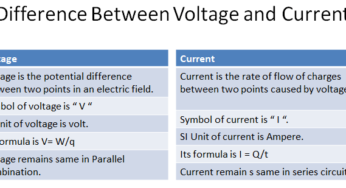Electricity & Megnetism
biot savart law:definition, examples, problems and applications
What is the definition of biot savart law? Biot Savart law is defined as: "The magnetic induction at any point…
Difference Between Voltage and Current
The basic difference between voltage and current is that Voltage is the amount of energy per charge which is required…
Factors Affecting Resistance
Resistance is the property of the material that restricts the flow of electrons. There are four factors affecting resistance which…
Types of electromagnetic radiation in order of increasing wavelength
There are 7 types of electromagnetic radiation which are given in the list below: Light Infrared radiation Microwaves radiations X-rays…
What is difference between step up and step down transformer?
The transformer is an electrical device that is used to step up or step down ac voltage. There are two…
5 band resistor colour code
Carbon resistors are most common in electronic equipment. They consist of a high-grade ceramic rod or cone ( called the…
Structure of atom for class 9 and 11
what is Atom? "Atom is the smallest particle of an element that possesses the unique characteristics of that element." All…
what is Difference between induced emf and induced current?
There are many ways to produce induced emf figures illustrated one of them. Consider a straight piece of wire of…
What is difference between electric field and electric field intensity?
The Basic Difference between electric field and electric field intensity is that, The electric field is a region around a…
Kirchhoff’s voltage and current law with examples
What is Kirchhoff's Voltage Law? Kirchhoff's voltage law is a fundamental circuit law that states that the algebraic sum of…

